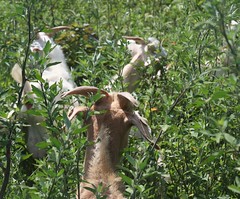Extension Agent, Washington County
A plant can be the apple of one person’s eye and the bane of another. One needs to remember that a weed is simply a plant out of place. When it comes to livestock producers, whether a plant is a weed will depend on what type of animal the producer is raising.
 To a dairy farmer, fescue can be a weed, but to a beef producer it is high quality winter feed. When it comes to small ruminants such as sheep and goats, the weed designation gets even more unclear. However, if you ask the average farmer if they consider marestail, chicory, lambsquarter and foxtail weeds, the almost unanimous response would be yes. The possible exception would be if you had a goat producer in the group.
To a dairy farmer, fescue can be a weed, but to a beef producer it is high quality winter feed. When it comes to small ruminants such as sheep and goats, the weed designation gets even more unclear. However, if you ask the average farmer if they consider marestail, chicory, lambsquarter and foxtail weeds, the almost unanimous response would be yes. The possible exception would be if you had a goat producer in the group.Currently at the Western Maryland Research and Education Center, there are 60 goats which are part of the Western Maryland Pasture-based Meat Goat Performance Test. The goats are maintained in a ten acre pasture consisting of five paddocks. The paddocks contain some of the usual suspects such as orchardgrass and fescue, but two paddocks are planted in unusual species.
One paddock contains two annual forages: turnips and pearl millet. The other paddock was seeded to perennial forage chicory three years ago. Finally, there is a paddock that was seeded to sericea lespedeza this spring and was a complete failure, but that is where things get interesting.
We often look at plants from a human perspective, but when we look at these same plants through the eyes and stomach of a goat, we see something completely different. We see food. What we saw as a crop failure, the goats saw as a buffet of marestail, lambsquarter and foxtail. In the chicory paddock, they ate the thistles first. I ask you weed or feed?
Since this behavior, which was not totally unexpected since goats are really browsers and not grazers, piqued my interest I took some forage samples of these perceived weeds and had them analyzed. I didn’t have the thistles tested, but I will get back to that later.
Below is the analysis of these forages. As you can see these “weeds” are of higher quality than most of the hay that is fed to our test bucks herd mates during the winter. As a matter of fact, the chicory tests higher than alfalfa hay, which would be the envy of every dairy farmer.
 Why didn’t I take a sample of the thistles? The goats beat me to them. In the chicory field there is a rock outcropping that was rife with thistles. When the goats were turned into that paddock they ate the thistles first. This I believe had more to do with behavior than with nutrition. The rock outcroppings are the high ground in the paddock, and this was the preferred position for the goats to set up camp. Below you can see the before and after pictures of the rock outcroppings.
Why didn’t I take a sample of the thistles? The goats beat me to them. In the chicory field there is a rock outcropping that was rife with thistles. When the goats were turned into that paddock they ate the thistles first. This I believe had more to do with behavior than with nutrition. The rock outcroppings are the high ground in the paddock, and this was the preferred position for the goats to set up camp. Below you can see the before and after pictures of the rock outcroppings.
 So, is that plant a weed or is it feed? I guess it depends on your point of view.
So, is that plant a weed or is it feed? I guess it depends on your point of view.











